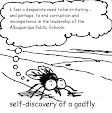There are 89,000 students in the APS, give or take.
Which means that at any given moment there are 89,000
personal agendas drawing students away from the the district's
agenda; yearly progress on standards based assessments.
APS designs strategies to help groups of students do well on
these tests. There are strategies for black students, hispanic
students, homeless students, college bound students, ...
There is no strategy to engage individual students. Every
student is expected to take their place in the five rows of six
students that move lock step through 12 years of education.
Which brings us to the most telling statistic of all that are
offered to us in the Journal this morning, link, and link,
a drop out rate near 50%.
The greatest, most important, and most incontrovertible truth
about education, is that it is a buyers market. Completely aside
from our arguments about which specific curricula are in
students' best overall interests; if we don't start paying some
attention to what they want to learn, half of them will leave
school without any kind of education at all.
Tuesday, August 04, 2009
89,001 agendas in the APS.
Posted by
ched macquigg
at
7:04 AM
![]()
Subscribe to:
Post Comments (Atom)

4 comments:
Back around 2000/2001, the Federal Department of Education asked that same question.
At the time, they had been successful in implementing the IEP (Individual Education Plans) for each Special Ed & ESL (English as a 2nd Language)student in most states. Soon after, it was suggested that maybe every student, General Ed, Special Ed and ESL should have their own IEP to ensure success. Debates ensued and the IEP for ESL students was dropped and the IEP-for-everyone was not talked about anymore.
Individual IEPs for each student isn't a bad plan, if it was tweaked, professional and taken seriously.
HOWEVER, an IEP for all students in classes of 16 or more (just a # I guesstamated)is impossible. On the other hand, an IEP for small classes would be very successful, I think.
NM state and APS will tell you that they have an IEP-style plan for all High school students, but all it does is double-check that credits are being filled properly for graduation.
On KOAT, it said that GED graduates and students that take longer than 4 years are not considered in the graduation rates in New Mexico. So, our graduation % data is flawed to begin with.
Lastly on this issue, APS refuses to have GED classes for older students, or students that are guaranteed not to graduate by the age of 21. When I proposed this class for day and/or evening, Admin said it was a definite "conflict of interest" and "Sends the wrong message". Their resolution is to simply kick the students out of the system when they reach 21, with no counseling on GED programs (like Catholic Charities) or any career counseling. The kids are deemed are "failures" and "unwanteds" and dismissed from Public education forever.
Thanks for your comment.
With respect to class size; if students were trained to be independent learners, the effective PTR can be raised substantially.
It is only because we insist that all knowledge come from the teachers mouth, that there is not time for teachers to attend to students individual needs; they are too busy lecturing to have time to teach.
Also, good point on shutting people out as some age. I once read a very interesting argument that if we allowed "adults" into classrooms, classroom dynamics, including student discipline, would greatly, and positively, affected.
You make a good point. There are very many APS High school teachers that are lecture-based in their classroom. Yet the kids are not trained in taking notes and seemingly get antsy and tune-out when they are lectured for too long.
However, many teachers continue this method, esppecially senior/traditional teachers in History and Language Arts. In my short time observing these classes, there is little student-teacher interaction and the rule of "church quite" is usually in effect the whole time.
I'm not convinced that the majority of teachers know how to create a classroom of critical thinking, or true student-focused classrooms where profound learning takes place.
And in retrospect, I know how to impart critical thinking methodologies, but I am often caught up in petty discipline issues that interrupt the profound learning process.
APS can waiver a student to stay in high school past the age of 20, but it is rare. Their reasoning is that 21+ students will introduce alcohol to other students and expose them to more adult situations. But that assumption is based on that under 21 students have no access to alcohol, drugs, pornography and parties, which we know is a blatantly false assumption.
And if high schoolers are failing courses that delay their graduation, summer school is never mandatory because students have to pay for summer school tuition (usually about $450/course). So what does this say about being student focused, and graduation rates/importance?
Thanks for reading and responding.
Post a Comment